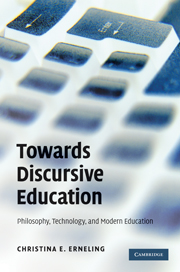Book contents
- Frontmatter
- Contents
- Acknowledgements
- Introduction
- 1 The infantilisation of learning
- 2 Educational technologies and pedagogy
- 3 Piaget and natural learning
- 4 Piaget's conception of the framework: from instincts to intentionality
- 5 The infant as scientist
- 6 The socio-cultural approach to learning
- 7 Towards discursive education
- Appendix
- References
- Index
6 - The socio-cultural approach to learning
Published online by Cambridge University Press: 05 June 2012
- Frontmatter
- Contents
- Acknowledgements
- Introduction
- 1 The infantilisation of learning
- 2 Educational technologies and pedagogy
- 3 Piaget and natural learning
- 4 Piaget's conception of the framework: from instincts to intentionality
- 5 The infant as scientist
- 6 The socio-cultural approach to learning
- 7 Towards discursive education
- Appendix
- References
- Index
Summary
INTRODUCTION: TWO DIFFERENT IDEALS OF PSYCHOLOGICAL ORDER
In previous chapters, and especially in Chapter 1, I claimed that there is a tendency towards the infantilisation of education. This is especially prevalent in the literature on the educational use of computer technologies. The ideas and arguments presented in this literature to a large extent rely on what can be called natural learning theories, which in general see learning as a natural process like the acquisition of one's first language and basic concepts and skills during infancy. Computer technology, according to this approach, helps schools create situations in which children learn everything in the same enjoyable and easy way they acquired basic cognitive skills in infancy, the paradigm of natural learning. One could also describe this as the infantilisation of science, since more recent theoretical approaches, represented by those of ‘theory theory’ and ‘theory of mind’, claim that infants and scientists reason in a similar way. It is these natural learning theories that I have discussed critically above. In this chapter, I shall present an alternative approach to learning, which instead sees socio-cultural activities, rather than natural individual reactions, as paradigmatic.
- Type
- Chapter
- Information
- Towards Discursive EducationPhilosophy, Technology, and Modern Education, pp. 129 - 155Publisher: Cambridge University PressPrint publication year: 2010



